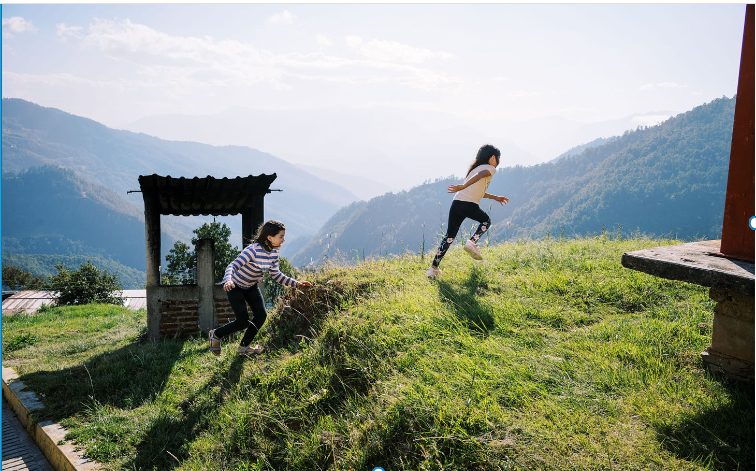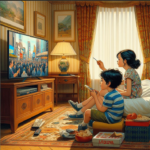






Can YOUR Kids Play Outside for FIVE HOURS?
To play outside for hours, unsupervised, no agenda, just free! For many of us, that was the whole goal of childhood. And for many of today’s kids, it’s not even on the radar. When they read about kids who play outside on their own, it seems like something that happens beyond the magic wardrobe, or in a cartoon.
And yet! This absorbing, longer-than-usual, and perhaps envy-inducing essay was originally published on Terms of Endearment, a newsletter by Sarah Menkedick about motherhood, travel, art, home education, Mexico, living a more mindful life — and letting kids play. Become a free or paid subscriber here.
Play Is Life, by Sarah Menkedick
I knew Elena and Valentina would hit it off the second Valentina decided to stand up in the bed of a pickup truck winding down hairpin turns on a ninety-degree slope on the side of a mountain.
“Can I do that?” Elena whispered to me, and I said, sure, because this is what I wanted her to know: the feeling of the wind in her hair in the open air, mountains all around, the world vivid and incredible and herself filled with awe in the middle of it.
The two girls stood with their long black hair whipping around them, watching as we wove past waterfalls and dozing bulls and glimpses of never-ending pine-covered peaks.
When we got to the village, they were off. Before I could orient myself they were clambering across a fallow corn field to the ledge of a tiny classroom, leaping into a void I couldn’t see. After that first leap I waited, heart briefly frozen, to see if Elena would re-emerge.
“Is that safe?”
Then up she came, her hands clawing on the cement ledge for purchase. Jorge and I ate beef soup with the town’s brass band at a local house, the señoras feeding 100+ people from a soup pot the size of a bathtub as part of the village fiesta. I caught glimpses of Elena here and there – dashing behind a building, streaking away from a hidden captor past the Shamel Ash tree at the village center, climbing into an abandoned camper van.
“Is that safe?” I asked Jorge and he shrugged and answered, “Looks like a good childhood to me,” but this from someone who at age 6 used to ride his bike downhill with no helmet and launch himself into a heap of used tires.
All day, Elena and Valentina played. They built a teepee out of sticks that Valentina broke with her teeth, earning Elena’s lifelong admiration. They played hide-and-seek and freeze tag. They swung on the swings and see-sawed on the see saw and spent some absurd length of time digging a hole under the seesaw in order to crush a Pringles can and fill the hole. They wrestled.
Playing with the best toy in the world.
The highlight of the day for both of them was finding an empty sugar sack – the massive kind used for potato-sack races – and crawling inside it, dragging each other around in it, rolling in it through the grass and squealing.
That night, we returned to Jorge’s village to sleep, but we came back to Temextitlán the following day around noon. It was cold that day – around 45 degrees, which for a mountain village with no heating and no real respite from the elements quickly becomes very frigid. There was a slight constant drizzle characteristic of this deep cloud forest. The señoras had wool blankets draped over their shoulders and any kid without a hat was inviting a rich scolding in Chinanteco or Spanish.
But nonetheless, in weather into which most U.S. kids would not venture for more than a few minutes, Valentina, Elena, and a band of village kids played for five hours. Nonstop.
But…where did they go?
While we wandered the village, taking pictures, going to our friend Eleuterio’s house for tamales and a mezcalito, they were playing.
At times, I caught glimpses of them. Once, I spotted all five girls huddled together on the stone plaza before the church. Then, a few minutes later, several of them were forming a tunnel with their arms and the others were racing through, forward, then backwards. Another time, I caught them dashing between various objects, screeching as they pursued one another.
After an hour or so of not seeing them, a bout of panic overtook me and I stalked through the pueblo, peering around corners. I finally found them all lounging against the wall of a house.
“What have you been doing?” I asked. By way of demonstration, one of the older girls led me over to a hill – “hill” being a generous interpretation, since this landform really fell somewhere between a hill and a cliff. The girl tipped her body over the edge and tumbled like a stone to the bottom, pounding across baseball-sized holes and rocks and outcrops as I gaped. In response, the other four girls launched themselves, slamming into one another and yelping until they came to a natural stop.
What has disappeared.
“Want to see the crabs?” one of the older girls asked, and when I inquired about where the crabs were, maybe sounding just a touch nervous, she looked at me like I was from another planet.
“Down by the river,” she said, “Don’t worry, it’s not totally in the mountains. There are still houses there.”
“Okay,” I said, as they were all racing off towards the river.
I haven’t seen play like this in a long time: real play, with no adult intervention or direction, no toys, no screens, no snacks, no water bottles, no backpacks or supplies. The kids only had their own ingenuity and the built environment.
They had no houses to retreat to, books or devices to zone out with. The day, with its clouds, rain, sun, whims, mud, trees, landscapes, was their canvas. I’d assume they had to be home by dark. That was it.
We don’t notice how rarely children play.
It’s easy to romanticize “before times,” “back in the day” simplicity – “when I was a kid we used to…” – and I think it’s healthy to be skeptical of this brand of nostalgia. However, one of the cases in which I think it’s truly merited is play.
American childhood is devoid of real play. This is not a new point, I know. But it’s an urgent one nonetheless.
American parents can become immune to just how rarely their children really play. Most of their day is spent in school, which is the opposite of play (and no, academic “games” meant to teach a concept are not play!). Then, maybe, children have organized sports, which are highly managed and directed by adults.
On weekends, perhaps, they have a play date with one or two other children, in which they can do the truly weird things that constitute play: wrestle one another on a trampoline while inventing a world in which they are orphaned foxes, play upside-down volleyball with a discarded piece of Styrofoam in which only left hands can be used and the Styrofoam is also fire, etc.
When kids have hours to play outside, the play changes.
Play, I understood while watching these girls prowl the village like kittens, is pure invention. Pure creativity.
It’s flow, it’s connection-making, it’s world-building, it’s synthesizing and testing one’s potential and mettle and skill. It’s finding one’s edge and pushing it just enough.
When I saw Elena leap, my heart also leapt – but when I looked at the jump I realized she actually knew what she was doing. She had calculated well. I would probably never have let her roll down that hill, but the other girls, who likely had done it before, had tested it.
This is not to say it’s all blissful perfect forest play. Playing fort in the backyard of Jorge’s aunt’s house in the mountains, Elena cut herself on a ragged piece of metal she used to try and cut open a pomegranate – which she had scavenged herself from a tree, to survive in the wilderness after she’d been abandoned by her wolf parents, obviously – and this sent us on a spiral of trying to figure out when her last tetanus shot was.
It’s hard to watch kids get hurt.
I debated whether we should continue to let her run around out of sight on this undeveloped slope of fruit trees and random discarded objects, corn and stray cats. After a big discussion about what is safe to play with and what isn’t, we let her head back out into the rain with her mud-streaked legs and plan to harvest and store lemons. It can be hard to know where to draw the boundary.
But what is clear to me is that play is a vital skill that kids need: a life force essential to creating the kind of world we all want to live in.
I have come to believe that we need so much less of the kind of rigid cognitive work of assessing and being assessed, analyzing and being analyzed, studying and regurgitating, applying algorithms and having them applied to us, and so much more of the raw imagination that comes with pure play.
How can we imagine our way out of this destructive, exploitative, life-crushing, climate-changing version of capitalism without it?
Trying not to romanticize play (or poverty).
When we were driving home, I waxed poetic about play with Jorge.
“Yeah, he said, “but later I wonder if those kids will have opportunities.”
“What do you mean?” I asked.
“Well,” he said, “Will they go to college, and get good jobs, and all that, or will they end up preparing food somewhere in a comedor?”
He compared them to many girls we knew in Oaxaca City, who were so quiet and tame and frightened to go very far from their homes – often with good reason – but who had been raised with lots of emphasis on schoolwork and the proper activities and then gone to college and gotten “good” jobs. They would have far more opportunities than many of these children deep in the Sierra, who would grow up with so much play, but so little of what the world actually values.
Jorge knew this from deep personal experience. He’d been lucky to earn a scholarship and work his way through college, but he’d later come to pursue, through his documentary photography, this world of indigenous culture he’d had to leave behind.
What does it mean to “succeed”?
“That’s so messed up,” I said.
“It is,” he replied. Our “modern” society often puts its emphasis in all the wrong places. Yes, I do believe we need school. I believe in books and book learning, in a beautiful education. But I believe play, and especially outdoor play with all that it encompasses – being in the natural world, making something delightful and difficult, believing in something that doesn’t exist yet and conjuring it, being tolerant of boredom and discomfort, finding resilience, negotiating with different personalities and tendencies – is central to that education.
Want a world with full, flourishing forests? Send kids out to play in it. Want a world with oceans free of trash and pollutants? Send kids out to play in it. Want a world with millions of species of plants and animals? Send kids out to learn their names, to sit and watch them for hours, which kids naturally love to do. Want a world where we aren’t all glued to the instant gratification and distraction of our screens? Get kids as far away from them as possible.
Want a world very different from the one we currently know? Let kids build the capacity to imagine it.
Actually, ALL kids can play for hours outside, without us.
Kids, actually, are very capable. They know how and love to play, and it’s a miraculous thing to witness. A miracle we’re in danger of losing.
I kept asking Elena what she did in the village.
“We played,” she answered, frustrated.
“But what did you play?” I asked, and she’d roll her eyes.
“Mom,” she sighed, “We played.” No more explanation needed. No discrete list of tasks, lessons learned, objectives checked off.
A whole day of flow, rolling, jumping, whispering, deciding, hiding, finding, resting, looking for crabs, swinging, leaping and feeling sun, wind, rain, mountains, life coursing through your flying hair.
*
Thank you for reading Terms of endearment. Sharing supports this work. To read more essays from Sarah, subscribe to Terms of endearment. 💜– S.M.

The hills are alive with the sound of…kids. Playing. Photo credit for this and other picture: Jorge Santiago
Want more about the importance of free play? Check out our Wisdom from Play Researcher and Let Grow co-founder, Peter Gray.



Yes, down with capitalism, it’s capitalism that’s destroying our children’s childhood! Capitalists hate children and hate childhood. They hate freedom! It’s definitely capitalists, and not socialists, insisting that children spend more and more time being educated by educators, and throwing up barriers to homeschooling, and pushing women into professional lives so that no one is home with children. Well-spotted!
I am so encouraged as I read this. My children were often not allowed to come inside the house all day, especially if I was working outdoors gardening. Their lunch would be wrapped up in a picnic blanket inside the cellar doors. The imaginative play, exploration and rest they enjoyed was possible because the house was off limits. The intentionality in doing this helped to produce enough time for them to become bored which often leads to creativity.
At times I have felt like my ways were too harsh.
It is wonderful to remember that it was all intentional and ultimately accomplished good in their lives. (A couple are still teens and I believe they need time like this too. The next time my son declines having a friend come over because “there’s nothing fun to do here,” I will remember this encouragement today and the fact that I want these children to experience enough time to feel free and creative.)
Everything described here sounds just like normal childhood in California in the 1960s. This is not romanticizing the “before times”. There’s no need to be skeptical of this brand of nostalgia. It’s literally a fact.